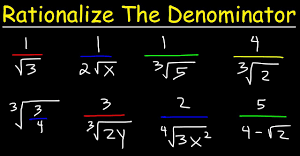Rationalizing a denominator means eliminating any radicals (like square roots) from the denominator of a fraction. To do this, multiply both the numerator and denominator by a value. This value should make the denominator a perfect square or a rational number.
Here’s an example: Suppose you have the fraction:
To rationalize the denominator, you multiply both the numerator and the denominator by square root of 2 as shown.
Now, the denominator is a rational number (2), and the fraction is rationalized
When a surd of order two is squared, a rational product is obtained. For example:
We have a fraction with surds in the denominator. We can remove the surd by multiplying it with a suitable surd. This multiplication will make the irrational denominator become rational.
Rationalizing the denominator is the process of making an irrational denominator rational. This is done by multiplying it with another irrational denominator.
For example:
please not that multiplying by
is by multiplying by 1. Hence the value has not changed in the fraction.
Multiplying a number by one does not change it’s value.
To rationalize the denominator of a fraction containing a surd (a radical expression), you want to eliminate the surd from the denominator or express it in a form where the denominator does not contain a radical. The steps includes:
i. Identify the surd in the denominator:
Look for the square root or other radical expression in the denominators
ii. Multiply both the numerator and the denominator by a suitable expression:
This expression should eliminate the radical from the denominator. To do this, multiply by the conjugate of the denominator, which is the same as the denominator but with the sign between the terms flipped.
For example, if the denominator is √a + b, then its conjugate is √a – b.
iii. Simplify the expression after Rationalizing a denominator
Multiply the terms in the numerator and denominator and combine like terms if possible. We combine terms that have the same surd into one term.
iv. Check for further simplification:
Sometimes, after rationalizing the denominator, you may be able to simplify the resulting expression further by factoring or simplifying.
Example
Rationalize the denominators in:
solution
(a)
(b)

Note: as you can see from the above workings, the irrational value in the denominator has been removed. Hence, we have rationalized the denominator.
Expanding the product

as shown above, the product of the two irrational sums have resulted to a relational number a-b.

that is :
A conjugate in surds is a surd with an expression such that the product of the two expressions results into a rational number.
One important application of conjugates is in removing of surds in denominators of surds expressions that have fractions. A denominator in the fraction is multiplied by it’s conjugate. A conjugate of a surd expression usually involves the same operands. The operators are changed to the opposite sign of the other operands.
When we have removed surd expressions in the denominator, we say that we have rationalized the denominator.
Example
Rational the denominators of the following surds:

Solution
(a)

(b)

Practice Problem
Given that √3 =m. Also, √5 and √13 =p. Rationalize the denominator and express your answer in terms of n, m, and p.
Related Topics
- Introduction to surds
- Order of surds
- Multiplying surds
- Simplifying surds
- Simplifying surds: Easy approach
- central tendency in statistics
- Clear Grouped Data Insights


Leave a Reply